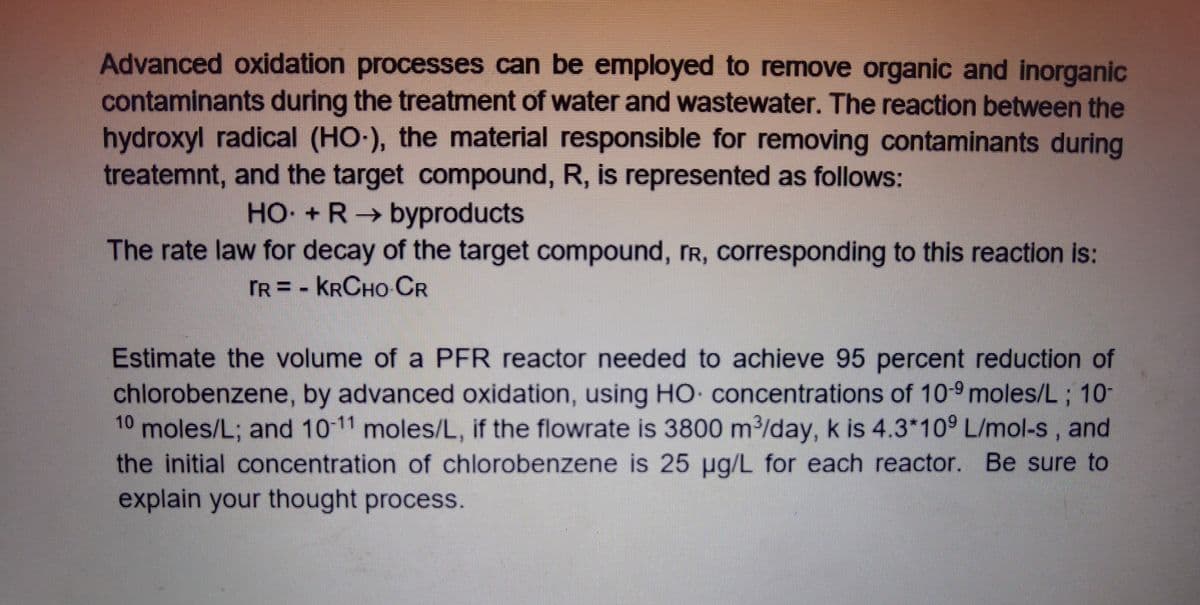Advanced oxidation processes can be employed to remove organic and inorganic contaminants during the treatment of water and wastewater. The reaction between the hydroxyl radical (HO-), the material responsible for removing contaminants during treatemnt, and the target compound, R, is represented as follows: HO +R→ byproducts The rate law for decay of the target compound, rR, corresponding to this reaction is: TR = - KRCHO-CR Estimate the volume of a PER reactor needed to achieve 95 percent reduction of chlorobenzene, by advanced oxidation, using HO concentrations of 10-9 moles/L; 10- 10 moles/L; and 10-11 moles/L, if the flowrate is 3800 m/day, k is 4.3*109 L/mol-s, and the initial concentration of chlorobenzene is 25 ug/L for each reactor. Be sure to explain your thought process.
Advanced oxidation processes can be employed to remove organic and inorganic contaminants during the treatment of water and wastewater. The reaction between the hydroxyl radical (HO-), the material responsible for removing contaminants during treatemnt, and the target compound, R, is represented as follows: HO +R→ byproducts The rate law for decay of the target compound, rR, corresponding to this reaction is: TR = - KRCHO-CR Estimate the volume of a PER reactor needed to achieve 95 percent reduction of chlorobenzene, by advanced oxidation, using HO concentrations of 10-9 moles/L; 10- 10 moles/L; and 10-11 moles/L, if the flowrate is 3800 m/day, k is 4.3*109 L/mol-s, and the initial concentration of chlorobenzene is 25 ug/L for each reactor. Be sure to explain your thought process.
Introduction to Chemical Engineering Thermodynamics
8th Edition
ISBN:9781259696527
Author:J.M. Smith Termodinamica en ingenieria quimica, Hendrick C Van Ness, Michael Abbott, Mark Swihart
Publisher:J.M. Smith Termodinamica en ingenieria quimica, Hendrick C Van Ness, Michael Abbott, Mark Swihart
Chapter1: Introduction
Section: Chapter Questions
Problem 1.1P
Related questions
Question
Question in picture

Transcribed Image Text:Advanced oxidation processes can be employed to remove organic and inorganic
contaminants during the treatment of water and wastewater. The reaction between the
hydroxyl radical (HO-), the material responsible for removing contaminants during
treatemnt, and the target compound, R, is represented as follows:
HO + R byproducts
The rate law for decay of the target compound, rR, corresponding to this reaction is:
TR = - KRCHO CR
Estimate the volume of a PFR reactor needed to achieve 95 percent reduction of
chlorobenzene, by advanced oxidation, using HO concentrations of 10-9 moles/L ; 10-
moles/L; and 10-11 moles/L, if the flowrate is 3800 m/day, k is 4.3*10° L/mol-s, and
the initial concentration of chlorobenzene is 25 ug/L for each reactor. Be sure to
explain your thought process.
10
Expert Solution
This question has been solved!
Explore an expertly crafted, step-by-step solution for a thorough understanding of key concepts.
Step by step
Solved in 2 steps

Recommended textbooks for you

Introduction to Chemical Engineering Thermodynami…
Chemical Engineering
ISBN:
9781259696527
Author:
J.M. Smith Termodinamica en ingenieria quimica, Hendrick C Van Ness, Michael Abbott, Mark Swihart
Publisher:
McGraw-Hill Education

Elementary Principles of Chemical Processes, Bind…
Chemical Engineering
ISBN:
9781118431221
Author:
Richard M. Felder, Ronald W. Rousseau, Lisa G. Bullard
Publisher:
WILEY

Elements of Chemical Reaction Engineering (5th Ed…
Chemical Engineering
ISBN:
9780133887518
Author:
H. Scott Fogler
Publisher:
Prentice Hall

Introduction to Chemical Engineering Thermodynami…
Chemical Engineering
ISBN:
9781259696527
Author:
J.M. Smith Termodinamica en ingenieria quimica, Hendrick C Van Ness, Michael Abbott, Mark Swihart
Publisher:
McGraw-Hill Education

Elementary Principles of Chemical Processes, Bind…
Chemical Engineering
ISBN:
9781118431221
Author:
Richard M. Felder, Ronald W. Rousseau, Lisa G. Bullard
Publisher:
WILEY

Elements of Chemical Reaction Engineering (5th Ed…
Chemical Engineering
ISBN:
9780133887518
Author:
H. Scott Fogler
Publisher:
Prentice Hall


Industrial Plastics: Theory and Applications
Chemical Engineering
ISBN:
9781285061238
Author:
Lokensgard, Erik
Publisher:
Delmar Cengage Learning

Unit Operations of Chemical Engineering
Chemical Engineering
ISBN:
9780072848236
Author:
Warren McCabe, Julian C. Smith, Peter Harriott
Publisher:
McGraw-Hill Companies, The